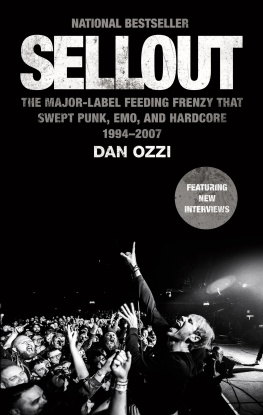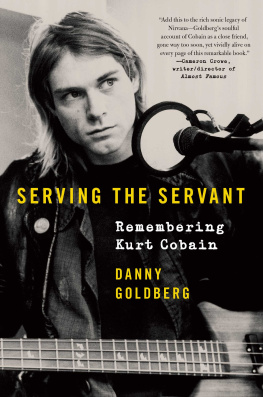THE
STRANGEST
TRIBE
THE
STRANGEST
TRIBE
How a Group of Seattle Rock Bands
Invented Grunge
STEPHEN TOW

Copyright 2011 by Stephen Tow
All rights reserved. No portion of this book may be reproduced or utilized in any form, or by any electronic, mechanical, or other means, without the prior written permission of the publisher.
Published by Sasquatch Books
| 17 16 15 14 13 12 11 | 9 8 7 6 5 4 3 2 1 |
Cover photograph: Charles Peterson
Interior photographs: Charles Peterson, Neil Hubbard, Marty Perez, and Stephen Tow
Cover design: Henry Quiroga
Interior design and composition: Emily Ford
Library of Congress Cataloging-in-Publication Data
Tow, Stephen.
The strangest tribe: how a group of Seattle rock bands invented grunge / Stephen Tow.
p. cm.
Discography: p.
Includes bibliographical references and index.
ISBN 978-1-57061-743-0
1. Grunge musicWashington (State)SeattleHistory and criticism.
2. Alternative rock musicWashington (State)SeattleHistory and criticism. I. Title.
ML3534.3.T69 2011
781.6609797'772--dc23
2011020055
Sasquatch Books
119 South Main Street, Suite 400
Seattle, WA 98104
(206) 467-4300
www.sasquatchbooks.com
In memory of my father,
Seymour Tow,
19181978.

CONTENTS
First, I would like to thank my interviewees who graciously shared their life experiences: Grant Alden, Dawn Anderson, Mark Arm, Jon Auer, Peter Barnes, Jim Basnight, Leighton Beezer, Matt Bischoff, Al Bloch, Kurt Bloch, Jane Brownson, James Burdyshaw, Shirley Carlson, Tina Casale, Chad Channing, Art Chantry, John Conte, Blaine Cook, Kurt Danielson, Mike Davidson, Amy Denio, Tad Doyle, Duff Drew, Jon Driver, Tom Dyer, Chris Eckman, Jack Endino, Craig Ferguson, Todd Fleischman, Steve Fisk, John Foster, Mike Fuller, Gillian Gaar, Milton Garrison, Jeff Gilbert, Greg Gilmore, Max Godsil, Stone Gossard, Terry Lee Hale, Chris Hanzsek, Faith Henschel-Ventrello, Paul Hood, Neil Hubbard, Ben Ireland, Calvin Johnson, Nate Johnson, Jeff Kelly, Joey Kline, David Kulczyk, Jamie Lane, Michael Laton, Jim Lightfoot, Pete Litwin, Kurtiss Lofstrom, Bret Lunsford, Scott McCaughey, Ben McMillan (R.I.P.), Lance Mercer, Dave Middleton, Courtney Miller, Gary Minkler, Rod Moody, Rob Morgan, Terry Morgan, Mike Musburger, Chris Newman, Kyle Nixon, Steve Pearson, Charles Peterson, Mark Pickerel, Poki (Hugo) Piottin, Tom Price, Chris Pugh, Stephen Rabow, Ned Raggett, Larry Reid, Rich Riggins, George Romansic, Joe Ross, Robert Roth, Ron Rudzitis, Scott Schickler, Nick Scott, Alex Shumway, Rob Skinner, Jeff Smith, Ken Stringfellow, Ben Thompson, Jim Tillman, Damon Titus, Dan Trager, Everett True, Conrad Uno, Steve van Liew, Scott Vanderpool, Bon Von Wheelie, Kim Warnick, Laura Weller-Vanderpool, Dennis White, Kevin Whitworth, Rusty Willoughby, Kevin Wood, and Blake Wright.
Second, I would like to offer an extra special thanks to the following people who went above and beyond the call of duty: Leighton Beezer for helping me connect the dots between 1983 and 1985; James Burdyshaw for setting up an interview with the U-Mens Tom Price; Kurt Danielson for his brilliant insight and supportive ear; Jack Endino for providing music, fanzines, and general encouragement; Chris Hanzsek for introducing me to Seattles neighborhoods and surrounding mountains; Jim Basnight and Paul Hood for providing a starting point; and Rob Morgan for being Rob Morgan.
Third, I would like to thank my agents Janet Rosen and Sheree Bykofsky; my editors Whitney Ricketts and Michelle Hope Anderson and everyone at Sasquatch Books who helped turn my vision into a reality; my sister Susan Louis for her unwavering support; Professor Charles Hardy for inspiring me; the helpful librarians at the University of Washington and Evergreen State College; and the photographers who contributed to this book: Charles Peterson, Marty Perez, and Neil Hubbard.
Finally, I want to thank my wife Irisa, my daughter Sami, and my labs Bear (R.I.P.) and Coco for their invaluable support and for putting up with me during this project. This book is dedicated to them.
When you look at really where the Seattle thing started, and how it got off the ground... I mean once there was [Nirvanas] Nevermind, its not hard to figure out why there was a Pearl Jam and a Soundgarden and everything elsebecause the phenomenon fed on itself quite easily. But how do you get to a Nevermind?
Leighton Beezer, the Thrown Ups
Seattle was rock and rolls last best hope. Not since Liverpool and Memphis has one city so dramatically altered the course of music history.
For many Americans, Seattle music equates only to grungea style of music exemplified by Nirvana, Pearl Jam, Soundgarden, and Alice in Chains. Grunge, in the eyes of the general population, was an early 90s fad remembered as fondly as that once hip but no longer fashionable pair of sneakers. Unfortunately, America has been culturally ripped off by the mainstream media and major labels, who painted a completely inaccurate picture of the music and portrayed the grunge band as a dark, angst-ridden group of depressed heroin addicts. Kurt Cobains 1994 suicide reinforced that notion. Grunge was serious.
If only they knew.
Seattles underground music has always displayed a tongue-in-cheek sense of humor. Rarely did anyone take themselves seriously, even people that became rock stars. The national media characterized the grunge musician as a dirty, long-haired, angry young man, shouting enraged commentary about his miserable life. Wait a minute, says Beezer, who played bass for the Thrown Ups, arguably the quintessential grunge band. These are like the funniest guys I know! Wheres the rage come from? [Laughs.] [It was about] getting drunk and having a good time. End of story!
The outside world just didnt get it, and Seattle wanted it that way. In 1992 a New York Times reporter phoned Megan Jasper, then a sales rep at Sub Pop Records. The caller inquired about the hip grunge slang. One problem remained, however: there was no hip grunge slang. Jasper, by then completely tired of the incessant media attention, decided to have some fun. She told the reporter to name some common terms, and she would happily provide the corresponding grunge expressions. As the reporter rattled off phrases like uncool person and hanging out, Jasper responded with lamestain and swingin on the flippity-flop. The exchange was published in the November 15, 1992, issue of the New York Times under the title Lexicon of Grunge: Breaking the Code. Jasper and Seattle enjoyed a good laugh.
Mudhoney, a Seattle grunge band then receiving international attention, decided to take the joke a step further. After the Lexicon of Grunge showed up in the Times, the band gave interviews with the made-up terms sprinkled throughout. When we heard about that, says Mudhoneys front man Mark Arm, [for] our next round of interviews we threw out as many of those terms as often as possible.
While Seattles humor often bordered on the macabre, it was typically not executed in a mean-spirited way. For instance, local record label owner Tom Dyer had a band called the Icons and desired publicity. He would send press releases to the Rocket, then Seattles monthly music magazine, only to be ignored. Then he came up with an idea: why not kill a fictional band memberWalter E. Goghand put that in the next press release? So we send this press release to the
Next page









